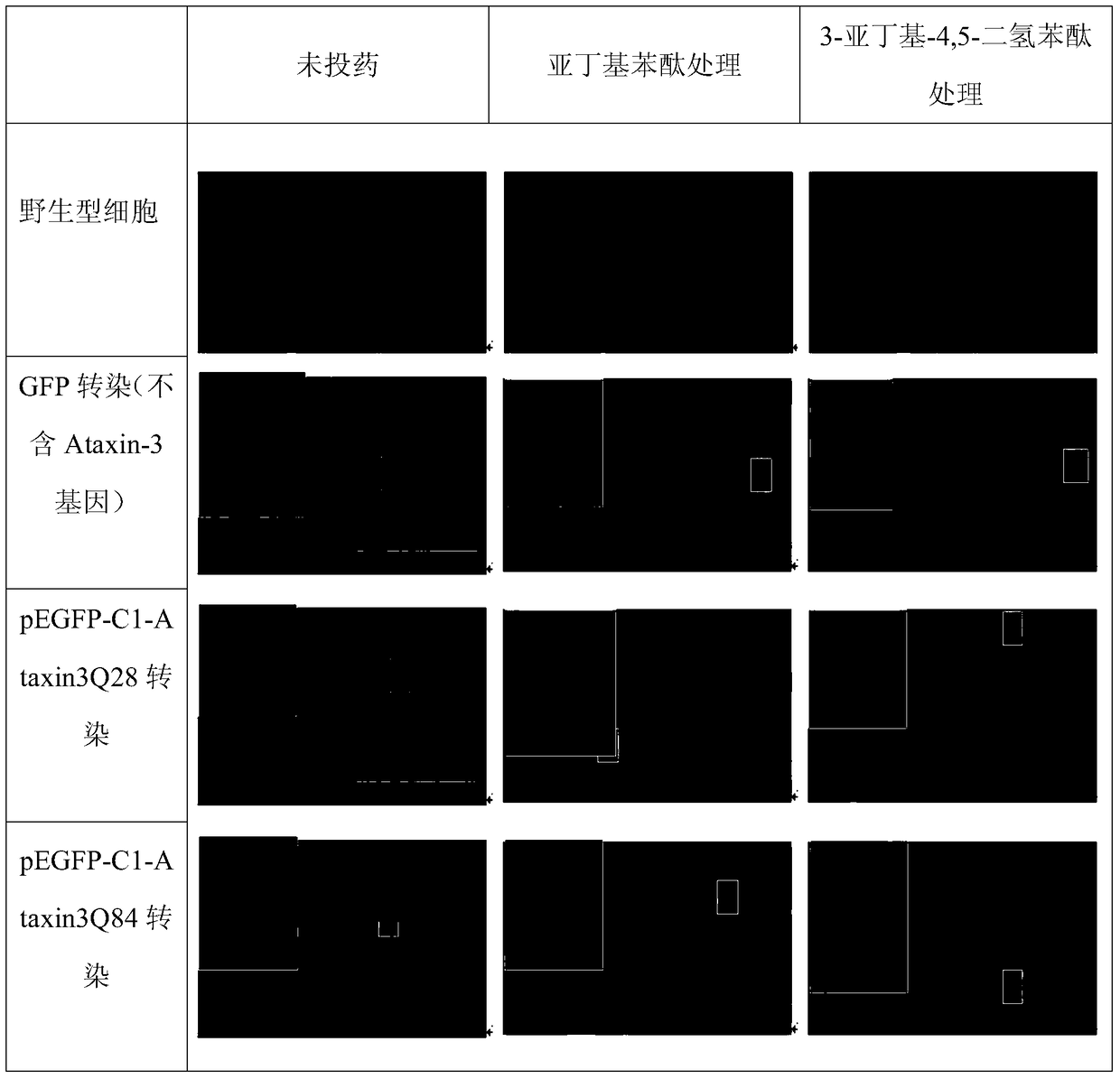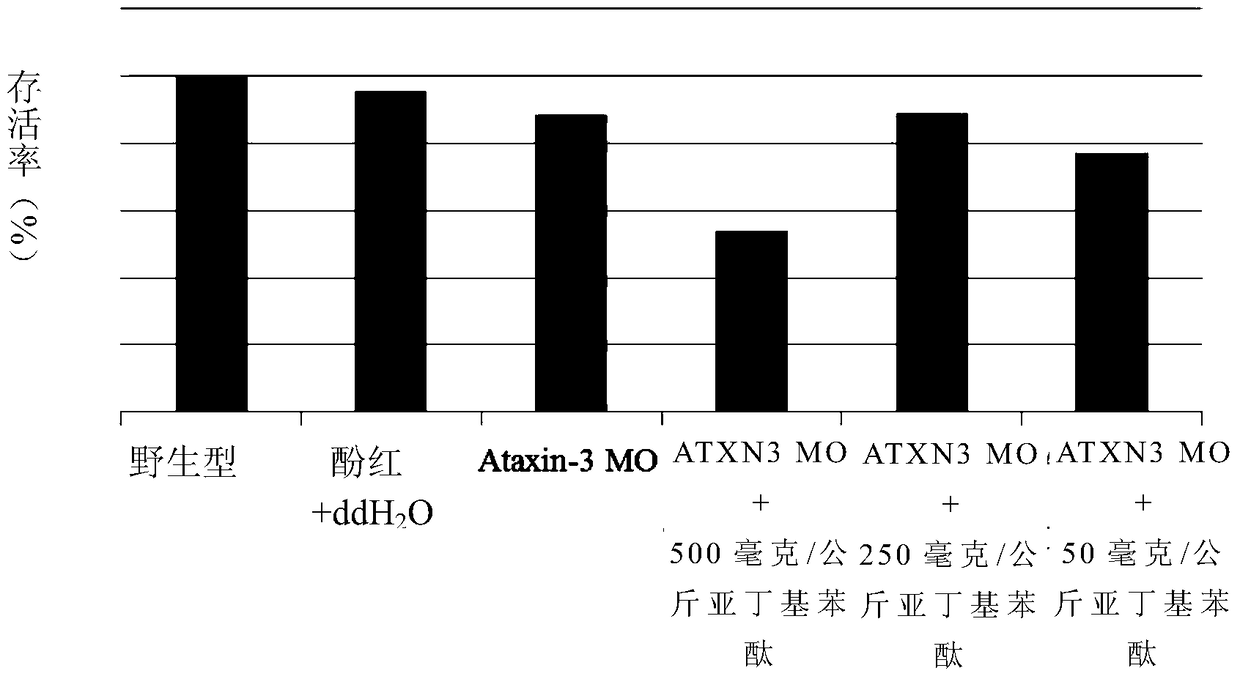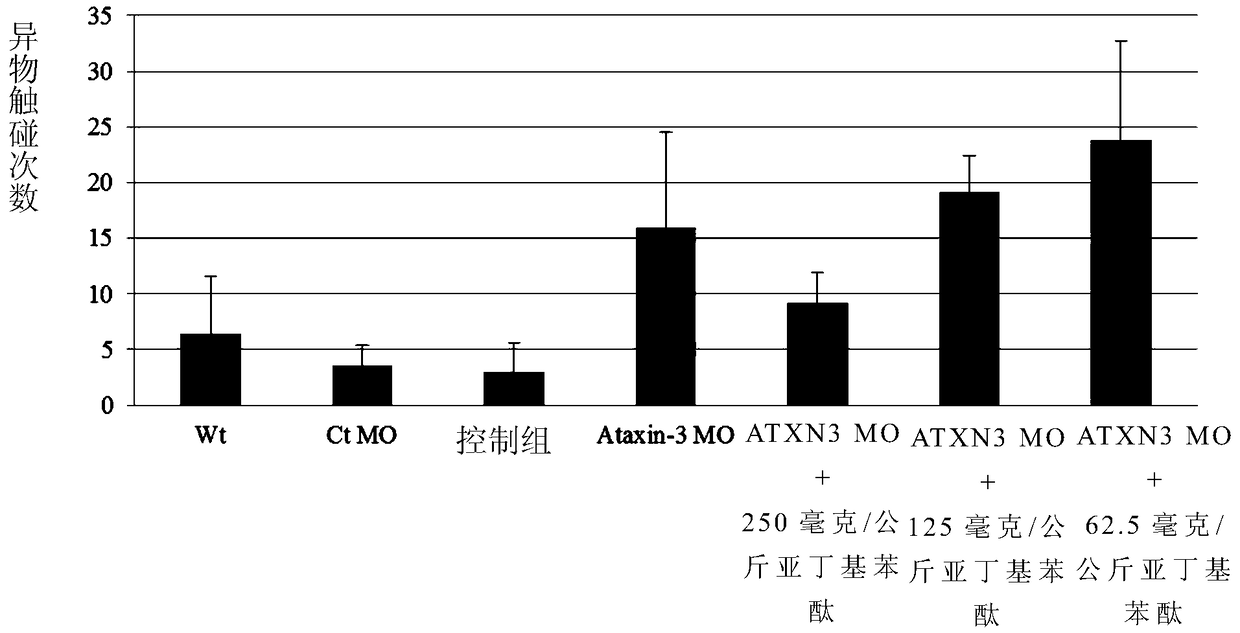Application of phthalide compounds
A kind of compound, the technology of phthalide, applied in the application field of phthalide compound
- Summary
- Abstract
- Description
- Claims
- Application Information
AI Technical Summary
Problems solved by technology
Method used
Image
Examples
Embodiment 1
[0038] [Example 1] In vitro cell test
[0039] cell transfection
[0040] This experiment tested the effect of butylenephthalide and 3-butylene-4,5-dihydrophthalide on the expression level of SCA3 protein. First, pEGFP-C1-Ataxin3Q84 (i.e., the plastid of the Ataxin gene with an abnormal number of CAG repeats (84Q)) or pEGFP-C1-Ataxin3Q28 plastid (i.e., the plastid with the normal number of CAG repeats (28Q)) containing green fluorescent protein The plastid of the Ataxin gene) (purchased from Addgene Company, the U.S.), through the transfection reagent ( 2000Transfection Reagent, Invitrogen TM ) into human embryonic kidney cells (Human embryonickidney, HEK) 293T ((Bioresource Collection and Research Center, Taiwan) or neural stem cells (Neural stem cell, NSC). Cells were cultured in 10% fetal bovine serum (Gibco) DMEM medium (Dulbecco's modified Eagle's medium, Thermo), in 5% CO 2 in a 37°C incubator. After that, butylenephthalide (A10353, purchased from Alfa Aesar, USA; ...
Embodiment 2
[0042] [Example 2] Zebrafish in vivo test
[0043] (1) Test safe dosage
[0044] In this experiment, zebrafish was used as the animal model. The zebrafish strain used in the experimental group was Tg(HuC:GFP), which is characterized by primary sensory neurons (Rohon-Beard cells) that can produce fluorescence, so it is convenient for observation. Wild-type strains were used, and all fish species were provided by TZCAS (Taiwan Zebrafish Core Facility at Academia Sinica, Taiwan) and TZCF (Taiwan Zebrafish Core Facility at Academia Sinica, Taiwan). First, to test the toxicity of butylenephthalide to zebrafish, inject different doses of butylenephthalide into zebrafish, culture them at 28.5°C, and observe their survival rate after 48 hours.
[0045] The result is as figure 2 As shown, the survival rate of wild-type zebrafish was 100%, while the survival rate of zebrafish injected with 500 mg / kg butylenephthalide was about 50%, and the survival rate of zebrafish injected with 250...
Embodiment 3
[0052] [Example 3] Mouse in vivo test
[0053] In this experiment, MJD84.2 gene-transformed mice (ie, mice transfected with human 84CAG repeated ATXN3 gene, referred to as SCA3 mice) were used for the experiment. MJD84.2 transgenic mice are animal models for the study of spinocerebellar atrophy. These mice will have abnormal gait within 4 weeks after birth, and then begin to show mild tremor and moderate mobility. Decreased, abnormal contraction of front / hind limbs (about 24 weeks old), and weakness on the ground.
[0054] (1) Treatment of MJD84.2 gene transfected mice
[0055] Two-week-old MJD84.2 gene transgenic mice were randomly divided into 5 groups, 6 mice in each group, and were treated for 2 weeks under the following conditions: (1) untreated; (2) fed with olive oil (i.e. , only fed adjuvant); (3) fed butylenephthalide 100 mg / kg / day divided into two feedings (bid); (4) fed butylenephthalide 500 mg / kg / day divided into two feedings (bid) ; (5) Feed 3-butylene-4,5-dihy...
PUM
| Property | Measurement | Unit |
|---|---|---|
| diameter | aaaaa | aaaaa |
Abstract
Description
Claims
Application Information
 Login to View More
Login to View More - R&D
- Intellectual Property
- Life Sciences
- Materials
- Tech Scout
- Unparalleled Data Quality
- Higher Quality Content
- 60% Fewer Hallucinations
Browse by: Latest US Patents, China's latest patents, Technical Efficacy Thesaurus, Application Domain, Technology Topic, Popular Technical Reports.
© 2025 PatSnap. All rights reserved.Legal|Privacy policy|Modern Slavery Act Transparency Statement|Sitemap|About US| Contact US: help@patsnap.com



